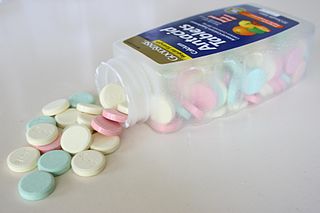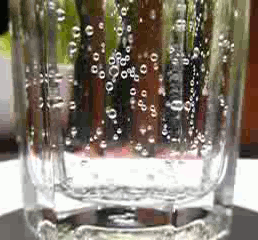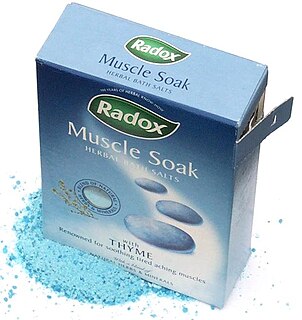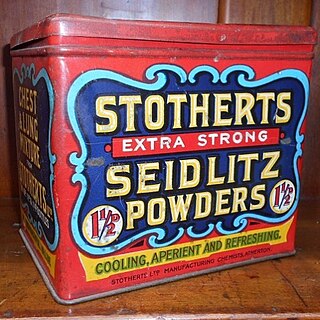
An antacid is a drug substance which neutralizes stomach acidity and bring relief of conditions like heartburn, hyperacidity related stomach distress. Some antacids have been used in the treatment of constipation and diarrhea. Marketed antacids contain salts of aluminum, and magnesium. Some preparations contain a combination of two salts, such as magnesium carbonate and aluminum hydroxide in order to balance the laxative effect of magnesium with aluminium ions.

Tartaric acid is a white, crystalline organic acid that occurs naturally in many fruits, most notably in grapes, but also in bananas, tamarinds, and citrus. Its salt, potassium bitartrate, commonly known as cream of tartar, develops naturally in the process of fermentation. It is commonly mixed with sodium bicarbonate and is sold as baking powder used as a leavening agent in food preparation. The acid itself is added to foods as an antioxidant E334 and to impart its distinctive sour taste. Naturally occurring tartaric acid is a useful raw material in organic chemical synthesis. Tartaric acid is an alpha-hydroxy-carboxylic acid, is diprotic and aldaric in acid characteristics, and is a dihydroxyl derivative of succinic acid.

Sodium bicarbonate (IUPAC name: sodium hydrogencarbonate), commonly known as baking soda or bicarbonate of soda, is a chemical compound with the formula NaHCO3. It is a salt composed of a sodium cation (Na+) and a bicarbonate anion (HCO3−). Sodium bicarbonate is a white solid that is crystalline, but often appears as a fine powder. It has a slightly salty, alkaline taste resembling that of washing soda (sodium carbonate). The natural mineral form is nahcolite. It is a component of the mineral natron and is found dissolved in many mineral springs.

Sodium carbonate, Na2CO3·10H2O, (also known as washing soda, soda ash and soda crystals) is the inorganic compound with the formula Na2CO3 and its various hydrates. All forms are white, odourless, water-soluble salts that yield moderately alkaline solutions in water. Historically, it was extracted from the ashes of plants growing in sodium-rich soils. Because the ashes of these sodium-rich plants were noticeably different from ashes of wood (once used to produce potash), sodium carbonate became known as "soda ash". It is produced in large quantities from sodium chloride and limestone by the Solvay process.

Baking powder is a dry chemical leavening agent, a mixture of a carbonate or bicarbonate and a weak acid. The base and acid are prevented from reacting prematurely by the inclusion of a buffer such as cornstarch. Baking powder is used to increase the volume and lighten the texture of baked goods. It works by releasing carbon dioxide gas into a batter or dough through an acid–base reaction, causing bubbles in the wet mixture to expand and thus leavening the mixture. The first single-acting baking powder, which releases carbon dioxide at room temperature as soon as it is dampened, was developed by food manufacturer Alfred Bird in England in 1843. The first double-acting baking powder, which releases some carbon dioxide when dampened, and later releases more of the gas when heated by baking, was first developed by Eben Norton Horsford in the U.S. in the 1860s.

Carbonated water is water containing dissolved carbon dioxide gas, either artificially injected under pressure or occurring due to natural geological processes. Carbonation causes small bubbles to form, giving the water an effervescent quality. Common forms include sparkling natural mineral water, club soda, and commercially-produced sparkling water.

Cream soda is a sweet soft drink. Generally flavored with vanilla and based on the taste of an ice cream soda, a wide range of variations can be found worldwide.

Trisodium citrate has the chemical formula of Na3C6H5O7. It is sometimes referred to simply as "sodium citrate", though sodium citrate can refer to any of the three sodium salts of citric acid. It possesses a saline, mildly tart flavor, and is a mild alkali.

Potassium bitartrate, also known as potassium hydrogen tartrate, with formula KC4H5O6, is a byproduct of winemaking. In cooking, it is known as cream of tartar. It is processed from the potassium acid salt of tartaric acid (a carboxylic acid). The resulting powdery base can be used in baking or as a cleaning solution (when mixed with an acidic solution such as lemon juice or white vinegar).

Eno is an over-the-counter antacid brand, produced by GlaxoSmithKline. Its main ingredients are sodium carbonate, Sodium bicarbonate and citric acid.

Creamola Foam was a soft drink produced in the form of effervescent crystals that were mixed with water. It was manufactured in Glasgow and sold mainly in Scotland from the 1950s, until Nestlé ended production in October 1998.

Bromo-Seltzer was a brand of antacid formulated to relieve pain occurring together with heartburn, upset stomach, or acid indigestion. It originally contained sodium bromide and acetanilide, both toxic substances subsequently removed. Its final formulation contained the pain reliever acetaminophen and two reactive chemicals – sodium bicarbonate and citric acid – which created effervescence when mixed with water. It is unclear if it contained any antacid.

Bath salts are water-soluble, pulverized minerals that are added to water to be used for bathing. They are said to improve cleaning, enhance the enjoyment of bathing, and serve as a vehicle for cosmetic agents. Bath salts have been developed which mimic the properties of natural mineral baths or hot springs. Some bath salts contain glycerine so the product will act as an emollient, humectant, or lubricant. Fragrances and colors are often added to bath salts; the fragrances are used to increase the users' enjoyment of the bathing experience.

Sodium sesquicarbonate (systematic name: trisodium hydrogendicarbonate) Na3H(CO3)2 is a double salt of sodium bicarbonate and sodium carbonate (NaHCO3 · Na2CO3), and has a needle-like crystal structure. However, the term is also applied to an equimolar mixture of those two salts, with whatever water of hydration the sodium carbonate includes, supplied as a powder.

Seidlitz powders is the generic name under which a commonly known laxative and digestion regulator was marketed and sold by numerous manufacturers under names such as "Rexall Seidlitz Powders", particularly in the late 19th and early 20th centuries.

Sherbet is a fizzy, sweet powder, usually eaten by dipping a lollipop or liquorice, or licking it from a finger.

Effervescent or carbon tablets are tablets which are designed to dissolve in water, and release carbon dioxide. They are products of compression of component ingredients in the form of powders into a dense mass, which is packaged in blister pack, or with a hermetically sealed package with incorporated desiccant in the cap. To use them, they are dropped into water to make a solution. The powdered ingredients are also packaged and sold as effervescent powders or may be granulated and sold as effervescent granules. Generally powdered ingredients are first granularized before being made into tablets.

Andrews Liver Salts is a laxative and antacid for mild stomach complaints. It is sold as a powder which is added to water and mixed, creating effervescence, before being swallowed. The powder contains sugar; an antacid, sodium bicarbonate ; citric acid ; and a laxative, magnesium sulphate. The product is similar to Eno's salts and Kruschen salts, and a mild form of Epsom salts. The term "liver salts" or "health salts" is typically used for a laxative.
James Crossley Eno was a 19th-century British pharmacist known for compounding and selling a brand of fruit salt that is still popular today as an antacid.


















